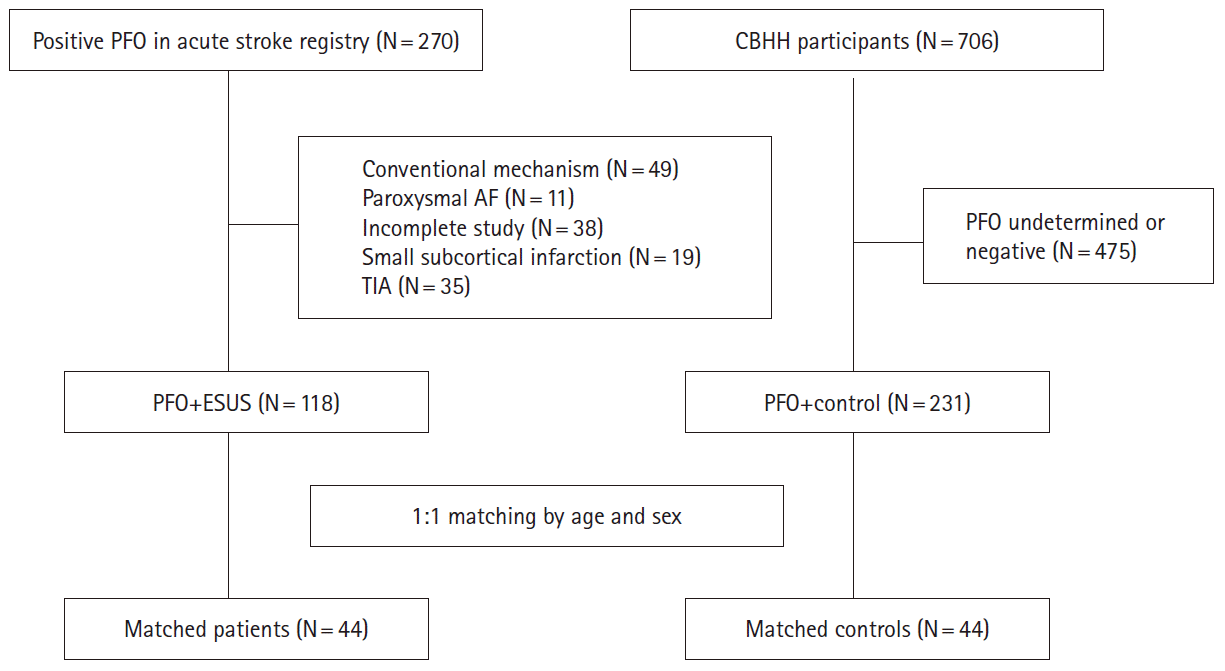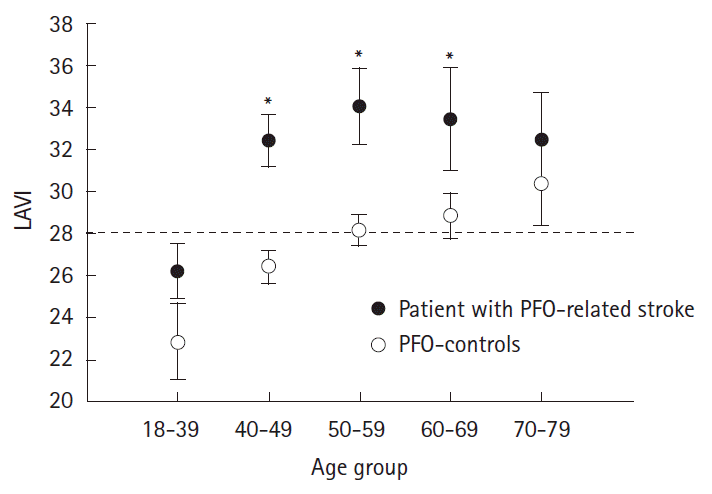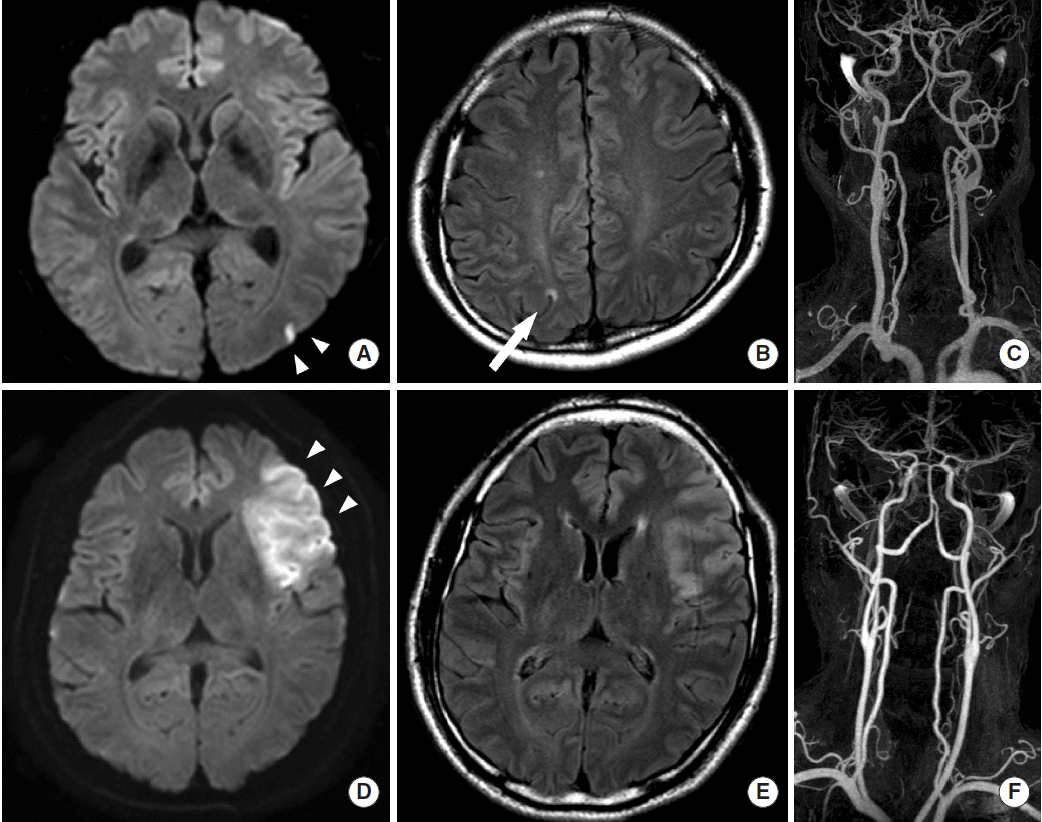Introduction
Patent foramen ovale (PFO) is prevalent in both the general population and stroke patients. Hence, it has been debated that PFO is a culprit of embolic stroke of undetermined source (ESUS) [1]. It was estimated that approximately one-third of PFOs discovered in cryptogenic stroke patients are likely to be incidental, and hence do not benefit from closure [2]. The probability of having a PFO as a possible cause of stroke in cryptogenic stroke patients may vary according to patient characteristics. Younger patients without vascular risk factors are much more likely to have a PFO than patients with conventional risk factors [3]. Several clinical and brain imaging features, including the 10-point Risk of Paradoxical Embolism (RoPE) score, have been suggested to determine a high-risk PFO [4].
Paradoxical embolism has been considered as the mechanism of PFO-related stroke. However, there are many conflicting reports regarding the role of paradoxical embolism in PFO-related stroke [5-7]. No association has been documented between shunt amount and stroke recurrence [8]. Moreover, PFO closure did not prevent stroke [9]. Clinical conditions such as deep vein thrombosis, a prolonged immobility/postoperative period, and the Valsalva maneuver were also not associated with embolism recurrence [10]. Taken together, a mechanism other than paradoxical embolism may contribute to the development of embolic stroke in patients with PFO [11].
Recently, left atrial (LA) dysfunction has been reported in patients with PFO [12,13]. Moreover, successful PFO closure reversed LA dysfunction [12]. These findings suggest a role of LA dysfunction in the development of embolic stroke in patients with PFO. However, no study has investigated LA function in the risk stratification of PFO-related stroke.
We postulated that LA dysfunction could be involved in the development of an arterial embolism in patients with PFO. LA function comprises reservoir, conduit, and pump functions, all of which are dependent on left ventricular diastolic function [14,15]. The LA volume index (LAVI), which is a biomarker of LA dysfunction that integrates the magnitude and duration of diastolic LV function, is strongly associated with cardiovascular disease and outcomes [14-17]. Thus, we compared the LAVIs between ESUS patients with PFO and healthy subjects with PFO. To evaluate whether LA dysfunction is responsible for either PFO-related stroke or suggestive of occult atrial fibrillation (AF), we further analyzed the infarct patterns and correlated them with markers of LA and LA appendage (LAA) dysfunction.
Methods
Patient selection
Using a prospective registry of consecutive patients who presented with acute ischemic stroke in the Samsung Medical Center from 2010 through 2014, we identified patients with PFO and ESUS (PFO+ESUS) using the following criteria [1]: (1) an acute ischemic stroke was defined using diffusion-weighted imaging (DWI); (2) DWI showed an embolic stroke pattern (i.e., not restricted to the deep subcortical region); (3) a PFO was documented using appropriate diagnostic methods; and (4) no conventional stroke mechanisms (e.g., a relevant arterial stenosis of >50%, a high-risk cardioembolic source such as AF, small artery disease, etc.) were identified despite a comprehensive work-up. We excluded patients with transient ischemic attack and those with a single subcortical infarct that was restricted to a perforator territory.
Controls
Healthy subjects with PFO served as controls (PFO+controls). We prospectively recruited subjects who visited a health promotion center and participated in the institutional heart and brain program (the Comprehensive Brain and Heart Health [CBHH] program) from January 2011 to July 2014. The CBHH is a program operated by an integrated team of specialized neurologists, neuroradiologists, neurosurgeons, and cardiologists, providing comprehensive evaluation and management for primary and secondary stroke prevention. The CBHH standard protocol includes brain magnetic resonance imaging (MRI), MR angiogram, 12-lead electrocardiography, and 2-dimensional transthoracic echocardiography. For CBHH participants who have no ischemic lesions in their brain images, no conventional sources of stroke (major intra- or extracranial arterial stenosis >50%) or other evident cardioembolic sources, and no stroke or transient ischemic attack, as confirmed in an interview with the stroke neurologist (O.Y.B.), transcranial Doppler (TCD) shunt tests were performed for the presence of right-to-left shunting. Subjects with positive TCD shunt tests were included as “PFO+controls”. A contrast echocardiogram was additionally conducted in 54 controls to measure septal movement. Among the PFO+controls, subjects were matched to individual PFO+ESUS cases based on gender and age. When more than 1 matched control was available, we selected 1 control at random. The Samsung Medical Center Institutional Review Board approved this study. All patients or patients’ guardians provided written informed consent.
Work-up
Comprehensive evaluations for the detection of embolic sources were performed in the PFO+ESUS patients. All the included stroke patients underwent routine laboratory tests, 12-lead electrocardiography, 2-D transthoracic echocardiography, 24-hour Holter monitoring, and/or >72 hour telemonitoring, brain MRI, and MR angiography. For patients who underwent Holter monitoring, the number of atrial premature complexes (APCs) was counted. Hemostatic markers of prothrombotic tendency were measured in patients younger than 50 years to exclude coagulopathies. Contrast transesophageal echocardiography (TEE) was the preferred method for detecting right-to-left shunting. In cases in which TEE was difficult to perform, a TCD shunt test was performed.
RoPE [4] scores were determined in all patients. The location of ischemic lesions could not be assessed in PFO+controls, therefore we defined a modified RoPE score (excluding the cortical infarct) with a range of 0-9 to equally compare clinical risk scores between patients and controls.
Contrast echocardiography
Two experts (S.J.P and J-w.H) who were blinded to the clinical information reviewed all of the contrast echocardiograms. The presence of PFO was defined as the appearance of microbubbles in the left atrium after intravenous injection of agitated saline, spontaneously and/or after a Valsalva or a cough maneuver. The atrial septal aneurysm was defined as a hypermobile septal excursion greater than 10 mm.
Echocardiography parameters
We collected echocardiographic parameters for all of the patients and control subjects. Biplane calculation of the LA volume was performed using LA areas, and lengths were measured from both the apical four- and two-chamber views, per previously established guidelines [21,22]. Calculated LA volumes were indexed to the body surface area (LA volume index, LAVI). As most of our subjects were within the normal range, a normal LAVI cutoff with 28 mL/m2 was used for the group comparisons [16,22]. In the PFO+ESUS patients whose echocardiogram images were retrievable for re-analysis, the LA and LAA functions were measured with the total LA stroke volume, total LA ejection fraction, and LAA emptying velocity. Detailed methods of measurement are described in the supplementary material.
Brain imaging analysis
Investigators who were blinded to the clinical information (M.J.L. and O.Y.B.) measured the maximal diameters, multiplicities, and lesion distributions of acute infarcts. All patients had embolic (i.e., cortical or cortico-subcortical) infarcts. Infarct patterns were classified as cortical (less than a lobar involvement) and cortico-subcortical (lobar or territorial involvement) to respectively represent PFO-related and AF-related patterns. In the case of multiple infarctions, the lesion pattern was determined with the maximal lesion. Chronic ischemic lesions were defined as a high-signal-intensity lesion of >3 mm in fluid attenuation inversion recovery sequence and a T1 hypointense signal in the corresponding area. These lesions were classified as cortical and cortico-subcortical infarcts using the same definition of acute infarctions. Periventricular and deep white matter hyperintensities were not considered as an infarction.
Statistical analysis
Chi-square tests, Fisher’s exact tests, and Mann-Whitney tests were used to compare binary and continuous variables between groups. Possible confounders were adjusted using an analysis-of-covariance (ANCOVA) test. To compare LAVI between groups, we performed a stratification analysis by each 10-year age group, and an age- and sex-matched analysis. For the analysis of matched samples, paired t-test and McNemar test were performed. Spearman’s tests was performed to evaluate correlations between continuous variables. Statistical analyses were performed using SPSS version 18.0 (SPSS Inc., Chicago, IL, USA). A P-value <0.05 was considered to be statistically significant.
Results
The study profile is shown in Figure 1. A total of 118 patients were classified as PFO+ESUS, while 231 subjects without stroke served as PFO+controls. The clinical and PFO characteristics are presented in Table 1. The PFO+ESUS patients had significantly more males, current smokers, and younger patients than the PFO+control group (Table 1). The shunt amount was larger in the PFO+ESUS group than the PFO+control group (P<0.001), albeit the diagnostic methods were different. The frequency of an atrial septal aneurysm was low in both groups (P=0.411, Table 1). Stratified comparisons of LAVI were made between all PFO+ESUS patients and all PFO+controls within each 10-year age group (Figure 2). LAVI was higher in the PFO+ESUS group than the PFO+controls within the age groups of 40-49, 50-59, and 60-69 years in which enough numbers of patients and controls were included (P<0.001, P=0.003, and P=0.027, respectively).
A total of 44 PFO+ESUS patients and 44 PFO+controls were included in the age- and sex-matched analysis. The demographics were comparable for both groups, with the exception of a higher prevalence of a previous stroke in the patient group (P=0.063, Table 2). The PFO+ESUS patients showed higher LAVIs than controls (mean of 32.2 (SD=9.60) mL/m2 vs. 26.6 (6.88) mL/m2, P=0.001 based on a paired t-test; Table 2). A high (>28 mL/m2) LAVI was documented in 63.6% of the PFO+ESUS patients and 36.4% of the PFO+controls (P=0.004). There was no association between shunt amount and LAVI (Spearman correlation P=0.346). In addition, no interaction between shunt amount and LAVI on the group assignment (ESUS vs. controls) was noted (P for interaction=0.405).
In the PFO+ESUS patients, the acute lesion patterns included cortical (52.5%), and cortico-subcortical (47.5%) patterns. Typical examples are shown in Figure 3. The cortical lesion pattern was more common in the PFO+ESUS patients with a higher (>28 mL/m2) LAVI than those with a lower LAVI (P=0.043, adjusted for age and shunt amount; Table 3). No other factors, including age, higher RoPE score, atrial septal aneurysm, redundancy, and the degree of right-to-left shunting were associated with a lesion pattern (data not shown). A higher LAVI was also associated with chronic cortical infarctions (P=0.024, adjusted for age and shunt amount; Table 3). The RoPE score was not associated with the size, number, location, or pattern of the acute infarct. The degree of right-to-left shunting was only associated with the presence of posterior involvement (P for trend=0.028), but not with other patterns of acute or chronic infarcts.
In the PFO+ESUS patients, the LAA emptying velocity, LA stroke volume, and LA ejection fraction were within normal range in most cases (Table 2). The LAA emptying velocity and LA ejection fraction showed no correlation with the LAVI, while the LA stroke volume was positively correlated with the LAVI (Spearman’s rho=0.344, P=0.004). The LAA emptying velocities, LA stroke volumes, and LA ejection fractions showed no correlation with the acute infarct lesion, in terms of maximal diameters, patterns, multiplicities, or sites of involvement (data not shown).
A total of 47 (39.8%) PFO+ESUS patients underwent Holter monitoring, and 71 (60.2%) received 72-hour in-hospital telemonitoring. Among the 47 Holter-monitored patients, no patients showed >150 APCs, and 11 (23.4%) patients showed no APCs, while 29 (61.7%), 5 (10.6%), and 2 (4.3%) patients had <25, 25-100, and 100-150 APCs, respectively.
Discussion
Our study showed that the PFO+ESUS patients had larger LA volumes than the PFO+controls. LA enlargement, but not a large amount of shunting, was associated with acute and chronic cortical (“PFO-related”) infarctions. These findings suggest that the left atrium may play a role in the pathophysiology of PFO-related stroke.
Our data suggest that PFO-related stroke is associated with LA enlargement. LA enlargement was also associated with a higher frequency of chronic cortical infarcts, which could imply recurrent embolic stroke. An enlarged LA can precipitate thrombus formation [14]. Whether the role of PFO on LA enlargement is causative, additive, or incidental has not been elucidated. One hypothesis is that a pathological PFO might contribute to atrial enlargement. Under normal conditions, PFO can allow only a right-to-left shunt because of the flap that covers it from the left side. However, when a distended LA stretches the foramen ovale or the flap valve is deficient, left-to-right shunting can occur [23]. In this situation, left-to-right shunting can cause LA volume overload, and consequently, LA enlargement. In contrast, another possibility is that cardiac thrombus that is secondary to LA enlargement might be a determinant of stroke and PFO is additive or even incidental.
Rigatelli et al. [12] reported that a moderate to severe atrial septal aneurysm was associated with LA dysfunction. However, most of our subjects did not have an atrial septal aneurysm. Therefore, it is not likely that a higher LA volume is the result of an atrial septal aneurysm. Rather, increased LA volume is more likely to be a mediator in the development of embolic stroke in subjects with PFO. Taken together, our results indicate that a mild LA enlargement may precipitate incident and recurrent embolism from PFO in the absence of overt LA dysfunction.
In our study, a large shunt amount was found in the ESUS group. However, shunt amount was associated only with posterior circulation infarcts. Furthermore, shunt amount did not interact with LA enlargement in the development or pattern of stroke. Diverse pathophysiological mechanisms can be present in PFO-related stroke. Paradoxical embolism can be a mechanism in the development of a posterior infarction, and thrombus formation in the LA may be related to recurrent small cortical infarctions. Further large-scale studies that focus on stroke phenotype are needed to test our hypothesis.
As a major cause of embolic stroke, occult AF may exist in patients with ESUS and an incidental PFO. LA dysfunction could also be a marker of incident AF, atrial thrombi, and thromboembolic risks of AF [17,24]. Rigatelli suggested that LA functions of PFO patients were lower than normal and similar to AF patients [12]. In addition, an increased incidence of interatrial block due to stretching of the interatrial septum was reported in patients with cryptogenic stroke and PFO, suggesting that atrial arrhythmia might underlie and mediate thrombus formation [13]. In our study, however, neuroimaging, TEE, and Holter monitoring data showed patterns that were distinct from those of paroxysmal AF [25,26]. The PFO+ESUS patients in our study had no markers of LAA dysfunction and infrequent APCs, reflecting a low possibility of occult AF [25]. We also analyzed an infarct pattern that enhances to infer stroke mechanisms. In the present study, a higher LAVI was associated with a small cortical pattern, suggesting a PFO-related stroke [27] without lobar or territorial infarctions, which are suggestive of a larger thromboembolism from a low-flow system such as AF [26,28]. These findings suggest that LA enlargement might be a factor in developing PFO-related stroke, rather than a marker of occult AF.
This study has several limitations. First, our controls were referred from the health promotion center and were willing to participate in the special program. The health-seeking nature of these controls might precipitate some unmeasured biases. In addition, the number of young (aged <40 years) controls was small, which led to insufficient case-control matching in young age groups. Second, for most of the subjects in the PFO+control group, a TCD shunt test was performed rather than TEE. The sensitivity and specificity of TCD tests for diagnosing a right to left shunt is compatible with TEE [29]. However, interatrial septal movement was not assessed in most of our control subjects. Furthermore, the opening size of the PFO was not measurable in most of our study subjects. Third, unrevealed conventional stroke mechanisms such as paroxysmal AF, and a mild degree of atherosclerotic stenosis that harbors unstable plaque may exist in our patients [26]. Longer-term monitoring, such as implantable cardiac monitoring [30,31], had not been available in Korea during our study period. Instead, we performed inpatient telemonitoring for >72 hours or Holter monitoring during admission, counted the number of APCs, and checked intermittent electrocardiography after discharge [25,32]. As a result, we excluded 11 patients showing paroxysmal AF during follow-up. Lastly, the results of our study should be interpreted with caution because we only included relatively small samples from a single center. In addition, ethnic differences in the prevalence of right-to-left shunting may exist [33]. Further studies involving different populations and larger cohorts are warranted.
Conclusions
In conclusion, LA enlargement might be a determinant of embolic stroke in subjects with PFO. LA enlargement was associated with a cortical infarct pattern and radiological evidence of stroke recurrence, even in the absence of an atrial septal aneurysm. These results would improve our understanding of the pathophysiology of PFO-related stroke.












